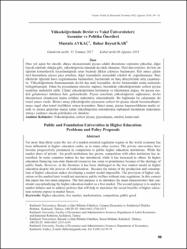| dc.contributor.author | Aykaç, Mustafa | |
| dc.contributor.author | Kar, Bahar Baysal | |
| dc.date.accessioned | 2021-12-12T16:49:01Z | |
| dc.date.available | 2021-12-12T16:49:01Z | |
| dc.date.issued | 2018 | |
| dc.identifier.issn | 1307-7112 | |
| dc.identifier.issn | 2667-6907 | |
| dc.identifier.uri | https://app.trdizin.gov.tr/makale/TXpBd05qVXlNZz09 | |
| dc.identifier.uri | https://hdl.handle.net/20.500.11857/1670 | |
| dc.description.abstract | Otuz yılı aşkın bir süredir, dünya ekonomisinde piyasa odaklı düzenleme rejiminin yükselişi, diğerbirçok sektörde olduğu gibi, yükseköğretim alanında da etkili olmuştur. Özel üniversiteler, devlete aitöğretim kurumlarıyla kıyaslandığında artan biçimde dikkat çekmeye başlamıştır. Kâr amacı güdenözel kurumların piyasa payı artarken, diğer kurumlarla arasındaki rekabet de yoğunlaşmıştır. Bazıülkelerde öğrenim harcı uygulamasına başlanırken, bazılarında ise harç düzeylerinde artış yaşanmıştır.Yükseköğretimin finansmanında devlet dışı mali kaynaklar, devlet fonlarındaki azalış nedeniylebelirginleşmiştir. Fakat bu piyasalaşma sürecine rağmen, literatürde yükseköğretimde serbest piyasamodeline muhalefet edilir. Çünkü yükseköğretimin üretiminin ve tüketiminin doğası, bir piyasa modeligeliştirmeyi imkânsız hale getirmektedir. Piyasa temelinde yükseköğretim sağlanması, devletdüzenlemesi olmaksızın kamu refahını maksimize etmemektedir. Bu bağlamda bu çalışmanın ikitemel amacı vardır. Birinci amaç yükseköğretim piyasasını serbest bir piyasa olarak kavramsallaştırmayaengel olan temel özellikleri ortaya koymaktır. İkinci amaç, piyasa başarısızlıklarını analiz etmekve piyasa güçlerine maruz kalan yükseköğretim sistemlerinin toplumsal faydalarını maksimizeetmeye yardımcı olacak politikaları ele almaktır. | en_US |
| dc.description.abstract | For more than thirty years the rise of a market-oriented regulation regime in the world economy has been influential in higher education realm, as in many other sectors. The private universities have become progressively prominent in comparison to public higher education institutions. While the market share of private –for profit-institutions has grown, competition with other institution has intensified. In some countries tuition fee has introduced, while it has increased in others. In higher education financing non-state financial resources has come to prominence because of the shortage of public funds. However, in the literature it has been challenged to the free market model in higher education despite this process of marketization. Because the nature of the production and consumption of higher education makes developing a market model impossible. The provision of higher education on the market basis would not maximize public welfare without state regulation. In this context this paper has two main purposes. The first purpose is to introduce the main characteristics that constraint conceptualizing the higher education market as a free market. The second purpose is to analyze market failures and to address policies that will help to maximize the social benefits of higher education systems expose to market forces. | en_US |
| dc.language.iso | tur | en_US |
| dc.relation.ispartof | Finans Politik ve Ekonomik Yorumlar Dergisi | en_US |
| dc.rights | info:eu-repo/semantics/openAccess | en_US |
| dc.subject | Tarih | en_US |
| dc.subject | Siyasi Bilimler | en_US |
| dc.subject | Sosyal Çalışma | en_US |
| dc.title | Yükseköğretimde Devlet ve Vakıf Üniversiteleri: Sorunlar ve Politika Önerileri | en_US |
| dc.title.alternative | Public and Foundation Universities in Higher Education: Problems and Policy Proposals | en_US |
| dc.type | article | |
| dc.department | Fakülteler, İktisadi ve İdari Bilimler Fakültesi, Çalışma Ekonomisi ve Endüstri İlişkileri Bölümü | |
| dc.identifier.volume | 55 | en_US |
| dc.identifier.startpage | 69 | en_US |
| dc.identifier.issue | 642 | en_US |
| dc.identifier.endpage | 92 | en_US |
| dc.relation.publicationcategory | Makale - Ulusal Hakemli Dergi - Kurum Öğretim Elemanı | en_US |



















